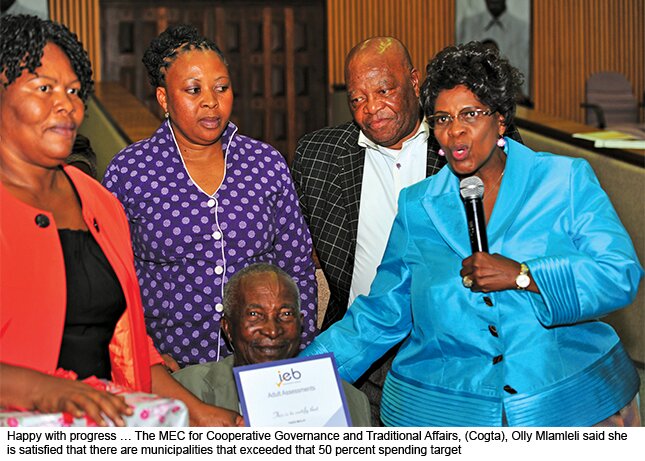Fast-tracking Municipal Spending

Free State municipalities are well on course to meet their commitment to spend their Municipal Infrastructure Grant (MIG) allocations on their planned projects before end of the financial year
The lack of proper planning, on the part of a number of municipalities and the inequitable distribution of jobs are largely responsible for deficiencies in service delivery, as well as the slow pace of transformation.
This emerged at a Municipal Infrastructure Grant (MIG) quarterly project management unit meeting which was held in Bloemfontein this week. The purpose of the meeting was to assess the financial spending expectations of the municipalities.
The MIG is a grant allocated to municipalities to fund their infrastructural projects, which form part of the Integrated Development Plan (IDP) of the municipalities. This plan includes a various service delivery programmes such as bulk water supply.
As a starting point, it turned out that Free State municipalities are well on course to meet their commitment to spend their Municipal Infrastructure Grant (MIG) allocations on their planned projects before end of the financial year.
The MEC for cooperative governance and traditional affairs (Cogta), Olly Mlamleli, observed that although there is evidence of progress in some municipalities, there are indications of commitment from others.
“The municipalities were expected to have spent 50 percent of the MIG by this quarter. We are pleased because there are municipalities that have exceeded this target. We told them that it is government’s responsibility to ensure that people are proud of the services they receive.
“This means proper sanitation and infrastructure. As the population in our townships grows, we need to ensure that water purification plants’ capacities are increased. This will accommodate this growth and ensure that all people get clean water and proper sanitation,” added Mlamleli.
Some municipalities did not reach their set implementation target. They are also not spending as much as they should have.
Six out of 19 local municipalities reached the January 2013 provincial expenditure target of 50 percent for the 2012/2013 financial year. Two municipalities reached a percentage of more than 40 percent. The remaining 11 local municipality spent less than 40 percent as at January 2013.
The six municipalities that are doing well in spending their MIG allocations are; Tokologo 64 percent, Tswelopele 54 percent, Phumelela 53 percent and Moqhaka at 51 percent. They are expected to reach 100 percent at the end of the 2012/13 financial year.
Two municipalities with the highest annual MIG allocation, namely the Matjhabeng and the Maluti-a-Phofung Local Municipalities are still under-spending. This is said to be having a significant influence on the provincial average monthly MIG expenditure.
The Kopanong, Mohokare, Masilonyana, Nala, Dihlabeng and Nketoana Local Municipalities are spending between the 20 and 30 percent mark. These are in critical condition and more intervention will be needed to assist.
This common poor performance was attributed to the fact that municipalities do not plan properly, something which has seen designs approved verbally in some cases, without using site visit report templates to report on site inspections, for example.
Mlamleli emphasised that there is no need for community uprisings if government representatives consult with the people.
She said there is a need for open communication to report on progress and challenges facing communities. This will keep people informed about developments in their communities and eliminated frustrations.
“I am going to recommend that when we are called to account to portfolio committees in the legislature or anywhere, we take along technical managers and municipal managers too. These are the people who have the expertise and first-hand information. If something needs to be explained, they will be the best placed people to do it.”
An issue that also took centre stage was of the lack of equitable distribution of jobs, which is characterised by continued marginalisation of women and people with disabilities in jobs created by municipalities.
A report presented at the meeting showed that few women and people with disabilities were employed. There were 1 483 jobs created by municipalities in the Free State from July to December 2012.
In the Setsoto Local Municipality a total of 459 jobs were created, but only 26 women were employed, while not a single disabled person was hired.
Maluti-a-Phofung Local Municipality generated 698 jobs; 233 of whom were women of which one is disabled woman and also three disabled men. The rest of the municipalities did not hire disabled people.
“This has raised a concern of gender balance when creating jobs. It is the responsibility of the municipality to enforce the employment of women.”
However, municipalities revealed their reasons for not reaching their planned targets. Phumelela Local Municipality representatives said there is a need for sector planning support. This will enable effective implementation of projects. This municipality insisted that planning after allocation of funds was time-consuming.
Though municipalities are slowly spending their grant, there is a large bucket system backlog in the province. As a result, municipal managers and mayors who took part in the meeting pledged their commitment to continue dealing with this challenge.
There are 2 600 buckets in the Mantsopa Local Municipality. This is a multi-year project that has a R51-million value now. This project should have been completed in 2007 but the municipality did not have running water then. It can take up to four years to complete. The same problem persists in the Phumelela Local Municipality and other municipalities.
The municipalities that were evaluated at this meeting were the Phumelela, Setsoto, Maluti-a-Phofung, Dihlabeng, Nketoana and Mantsopa Local Municipalities.




Follow Us onTwitter